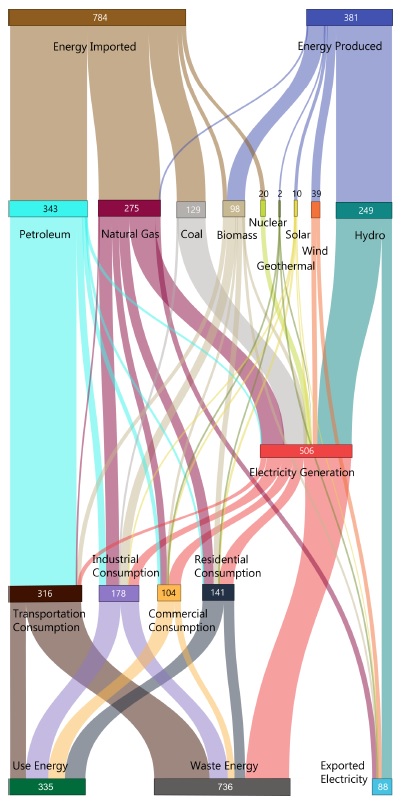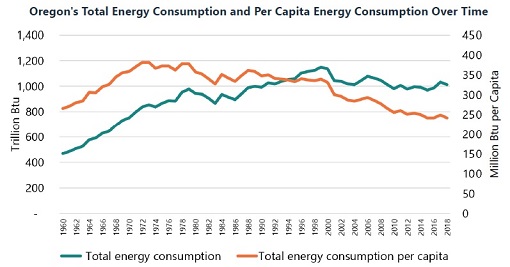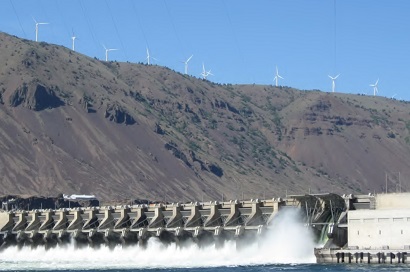A look at the current state of energy production and use
The Oregon Department of Energy is about to release it's
2020 Biennial Energy Report for the State of Oregon. The 612 page report is a comprehensive look at virtually every thing about energy, its production , its transportation, its consumption, and its future in Oregon.
Some very large basic facts about energy emerge.
- Oregon hasn't produced any nuclear power since the Trojan nuclear power plant was closed in 1993 after several mechanical failures. The state consumes some nuclear power purchased from facilities in Washington.
- While Oregon makes great use of fossil fuel energy -- oil, gas and coal -- none of these are produced in Oregon.
- Oregon does produce a great deal of hydroelectricity through a series of dams throughout the state. This hydro-power is renewable, clean and -- unlike wind and solar -- available around the clock.
- Oft discussed renewables like solar, wind and to a lesser extent geo-thermal play a small role in the big picture
- Despite Oregon's reputation for energy conservation, we import about 2/3 of the energy we use

The elephant in the room is the closure of the coal-fired electrical generation plant in Boardman. At the time of its closure, it produced about 25% of all electrical power in the state of Oregon. That energy will have to be replaced somehow, if you want to charge your Tesla, and the watts produced by the highly subsidized sources of wind and solar have a long way to go to make up the lost ground.
The report makes an interesting point about conservation -- especially in the light of the Boardman closure. "While energy efficiency is not 'consumed' like other resources, it is the second largest resource available in Oregon after hydropower. Efforts to increase energy efficiency effectively reduce overall energy consumption. Historically, Oregon has consistently met increased demand for electricity by implementing energy efficiency strategies." As the population of Oregon continues to climb, total energy use is flat, and energy use per capita is declining.
That's a good thing. That means we're driving more efficient cars, turning down the heat and lights and industry is finding leaner ways to keep the economy chugging along.
The report includes a lengthy section on hydraulic fracturing, known as “fracking.†Effectively demonized in the report, this process is what has allowed America to achieve energy independence during the last decade and kept gas prices low enough so that legislatively imposed price increases like the
low carbon fuel standard don't get noticed as much by consumers, who were prepared to pay $4.00 per gallon in the pre-fracking days.
That same legislature, two years earlier, had the "wisdom" of
making fracking illegal in Oregon, despite the fact that -- and the report doesn't really tell you -- there is no oil nor gas extraction in Oregon, so fracking never occurs. It has the same effect as banning alcohol at an Amish convention.
Conduit Hydropower is new, but fairly simple. Where water systems are gravity fed, it makes sense to
put small hydro-electric turbines in line and capture a small amount of energy from them. Many irrigation districts and municipal water districts rely on mountain-fed rivers and streams, and this is an opportunity. Gravity is certainly a clean and renewable resource.
In a state with some of the most oppressive land use laws in the nation, the prevalence of wind power in scenic and sensitive areas continues. One wonders if there was oil in the Columbia Gorge, if drilling and pumping equipment would be allowed to take up as much visual space as wind turbines. The report discusses some of the negatives of wind power. "Wind turbines can impact flora and fauna – in particular birds and bats can collide with wind turbine blades – however, newer designs have reduced collisions and fatalities. Wind turbines can be more than 600 feet tall and can have a visual impact on the landscape. Wind turbines take up land, but Oregon has requirements to protect wildlife and agriculture, and developers often site projects in dryland agricultural areas that allow for farming to continue up to and around turbines. In addition, transmission lines from facilities can similarly disturb sensitive environments, affect waterways, and cause habitat fragmentation." They forgot to mention taxpayer subsides. Maybe bats outrank taxpayers at the Energy Department.

Looking at the chart above and the amount of energy currently generated by wind, and keeping in mind what some places in the Columbia Gorge look like now, one can wonder what the Gorge will look like when (if?) wind becomes a more dominant slice in the energy pie.
A combination of policy and market factors is driving solar adoption. At the state level, Oregon has a long history of policy and program support for solar energy including net metering -- a policy that enables an electric utility customer to receive value for the electricity that they generate on site -- utility ratepayer incentives, and subsidies for solar installation. The Oregon Renewable Portfolio Standard established a target of 50 percent renewables for the state’s largest electric utilities by 2040.
Since 1999, Oregon law has required electric utilities to offer net metering to Oregon customers installing renewable energy systems up to 25 kilowatts in size. This law was amended in 2005, enabling the Oregon Public Utility Commission to adopt rules allowing customers of investor-owned utilities to install even larger systems.
Where the Department of Energy talks of "policy" and "market factors," economists might use terms like "mandate," "subsidy" and "incentive." In any case, these are the tools used on a daily basis to manipulate our energy usage, to get the energy picture to look like what the state wants it to look like.
The report will be presented to the legislature this week.
 --Staff Reports
--Staff Reports| Post Date: 2020-11-29 09:13:35 | Last Update: 2020-11-29 11:53:37 |







 The elephant in the room is the closure of the coal-fired electrical generation plant in Boardman. At the time of its closure, it produced about 25% of all electrical power in the state of Oregon. That energy will have to be replaced somehow, if you want to charge your Tesla, and the watts produced by the highly subsidized sources of wind and solar have a long way to go to make up the lost ground.
The elephant in the room is the closure of the coal-fired electrical generation plant in Boardman. At the time of its closure, it produced about 25% of all electrical power in the state of Oregon. That energy will have to be replaced somehow, if you want to charge your Tesla, and the watts produced by the highly subsidized sources of wind and solar have a long way to go to make up the lost ground.
 Looking at the chart above and the amount of energy currently generated by wind, and keeping in mind what some places in the Columbia Gorge look like now, one can wonder what the Gorge will look like when (if?) wind becomes a more dominant slice in the energy pie.
Looking at the chart above and the amount of energy currently generated by wind, and keeping in mind what some places in the Columbia Gorge look like now, one can wonder what the Gorge will look like when (if?) wind becomes a more dominant slice in the energy pie.
